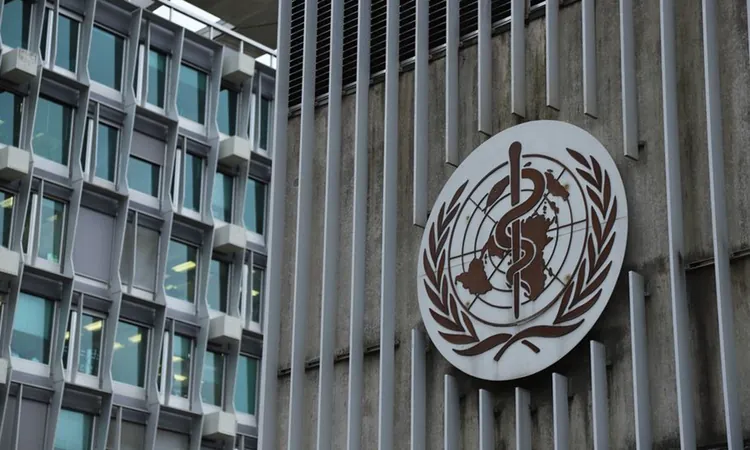
WHO Declares HMPV Not a New Threat in China: Hospital Resources Remain Stable
2025-01-08
Author: Ming
Introduction
As the winter season ushers in a spike of respiratory illnesses, recent reports from international media outlets have raised alarms about a purported surge in Human Metapneumovirus (HMPV) cases in China. Some sources have sensationalized claims that hospitals are being overwhelmed, drawing unwarranted parallels to the COVID-19 pandemic. However, the World Health Organization (WHO) has set the record straight, clarifying that HMPV is not a new virus and is, in fact, relatively common, presenting symptoms akin to a common cold.
WHO's Clarification
According to WHO officials, the current levels of respiratory infections in China are consistent with what is typically expected during winter months. In fact, utilization of hospital resources is reported to be lower than it was at the same time last year, and there have been no emergency declarations or heightened responses to this seasonal spike.
Media Sensationalism
Despite widespread fearmongering by news giants such as CNN, BBC, and the Washington Post, it appears that the increase in respiratory cases falls well within the normal range for the season. The WHO, in consultation with the Chinese Centre for Disease Control and Prevention (China CDC), emphasized that while there is a general rise in common respiratory infections, these are primarily seasonal fluctuations.
Surveillance and Monitoring
Notably, the WHO has validated China's approach to monitoring respiratory illnesses, highlighting a sophisticated sentinel surveillance system designed to track influenza-like illnesses and severe acute respiratory infections throughout the country. The surveillance data reveals that prevalent pathogens in circulation include not only HMPV but also seasonal influenza and SARS-CoV-2.
Influenza Trends
Among these pathogens, the seasonal influenza virus leads the pack and has been on the rise. WHO's Global Influenza Surveillance and Response System has noted similar trends across the Northern Hemisphere, signaling a worldwide uptick in influenza cases during this winter season.
Understanding HMPV
HMPV, which was first identified in 2001, typically circulates during the winter and spring months. While most infections are mild, it can occasionally lead to more serious ailments like bronchitis and pneumonia, particularly in vulnerable populations, including the very young, the elderly, and those with compromised immune systems.
Current Influenza Statistics
According to recent statistics from the China CDC, a staggering 99% of detected influenza cases are attributed to subtype A(H1N1) pdm09, signaling a concerning increase in influenza activity, particularly in northern provinces of the country. Traditional Chinese medicine is being pushed as one of the preventative measures against flu, reflecting a holistic approach to health amidst rising concerns.
Public Awareness and Detection
Li Tongzeng, a chief physician at Beijing You'an Hospital, highlighted that awareness of HMPV in the Chinese public has ramped up significantly over the past two years. This surge in awareness coincides with significant improvements in the country's pathogen detection capabilities, which have been greatly advanced since the onset of the COVID-19 pandemic.
Improved Monitoring Systems
The establishment of a multitude of sentinel hospitals across China has also played a crucial role in monitoring respiratory pathogens. This development has led to timely updates from the China CDC on circulating pathogens, enhancing public health responses and awareness. Moreover, drug stockpiles to combat seasonal respiratory viruses have reportedly improved, ensuring better preparedness for the health challenges of winter.
Conclusion
As the world watches closely, it is essential to separate facts from sensationalism and remain vigilant but informed. The message from health authorities is clear: HMPV is not a new threat, and while respiratory illnesses are on the rise, the health system is equipped to manage these seasonal increases.
 Brasil (PT)
Brasil (PT)
 Canada (EN)
Canada (EN)
 Chile (ES)
Chile (ES)
 Česko (CS)
Česko (CS)
 대한민국 (KO)
대한민국 (KO)
 España (ES)
España (ES)
 France (FR)
France (FR)
 Hong Kong (EN)
Hong Kong (EN)
 Italia (IT)
Italia (IT)
 日本 (JA)
日本 (JA)
 Magyarország (HU)
Magyarország (HU)
 Norge (NO)
Norge (NO)
 Polska (PL)
Polska (PL)
 Schweiz (DE)
Schweiz (DE)
 Singapore (EN)
Singapore (EN)
 Sverige (SV)
Sverige (SV)
 Suomi (FI)
Suomi (FI)
 Türkiye (TR)
Türkiye (TR)
 الإمارات العربية المتحدة (AR)
الإمارات العربية المتحدة (AR)